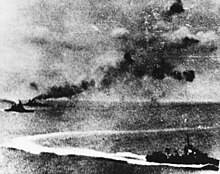HMS Prince of Wales (53)
|
||||||||||||||||||
|
||||||||||||||||||
|
||||||||||||||||||
|
||||||||||||||||||
The HMS Prince of Wales , ( 53 ), was a British battleship of the King George V class , which during the Second World War was used. She was the second ship of this class in the Royal Navy .
history
Hunt for the Bismarck
Your first order in May 1941 was to sail out with the battle cruiser Hood and to prevent the German battleship Bismarck and the heavy cruiser Prinz Eugen from breaking into the Atlantic . However, the ship was not yet fully operational and civilian engineers from Vickers-Armstrong remained on board to troubleshoot problems that were particularly common with the main artillery while underway.
During the battle in the Denmark Strait, the Hood was sunk by the Bismarck with a few volleys and the remaining Prince of Wales was damaged (see also: Operation Rhine Exercise ). In addition, some of their guns failed, so that their commander was forced to abandon the battle. The Germans refrained from pursuing them.
Atlantic Charter
In August 1941, the Prince of Wales brought British Prime Minister Winston Churchill to a meeting with US President Franklin D. Roosevelt in Argentia ( Newfoundland ), where the Atlantic Charter was adopted on August 14, 1941 , which became the basis the United Nations became.

Sinking
At the end of October 1941, the battleship ran to Singapore to reinforce British Force Z in the Far East in view of an expected attack by the Imperial Japanese Navy . On December 10, 1941, the Prince of Wales and the Repulse , coming from Singapore, were attacked by Japanese naval air forces off the east coast of the Malay Peninsula near Pulau Tioman and sunk by several bombs - and above all torpedo hits . The Prince of Wales was a chance hit to fatal. One of the torpedoes hit the shaft pants of the port outer shaft, with the shaft running at high speed being torn from its bearings, which led to water ingress through the shaft tunnel and severe damage to the interior of the ship. The air flowing in through the shattered shaft tunnel water caused a strong list , which greatly hampered the turning of the flak towers. Due to the flooding of part of the generator rooms , the drive for half of the guns failed. So at the mercy of its attackers, the Prince of Wales was sunk within a short time by further bombs and torpedo hits. Their wreck lies at the coordinates 3 ° 34 ' N , 104 ° 29' O .
327 seamen died in the sinking, 1,285 were rescued by the destroyers accompanying them.
The Repulse and Prince of Wales were the first battleships to be lost in the open sea in an air raid with torpedoes - which had already proven their effectiveness during the Japanese attack on Pearl Harbor three days earlier. The Prince of Wales was only in service for seven months and her demise - just months after losing the Hood - was another blow to the British.
Wreck looting
In 2014 it was announced in the English newspaper The Daily Telegraph that the wreck of the Prince of Wales had repeatedly been the target of looters from 2012 onwards. Non-ferrous metals such as For example, ship propellers made of phosphor bronze with a total weight of over 15,000 kg were stolen, at a scrap price of 3,800 pounds per ton at the time . The British government protested because the wreck is classified as a naval war grave and is thus legally protected from salvage and looting.
literature
- Martin Middlebrook, Patrick Mahoney: Battleships. Ullstein Verlag, ISBN 3-548-23535-2 .
- Niklas Zetterling, Michael Tamelander: Bismarck. The Final Days of Germany's Greatest Battleship. Casemate, 2009, ISBN 978-1-935149-04-0 .
- William H. Garzke Jr., Robert O. Dulin Jr .: British, Soviet, French, and Dutch Battleships of World War II . Jane's Publishing Company, London 1980, ISBN 0-7106-0078-X , pp. 167-255 .
- Robert Gardiner (Ed.): Conway's All the World's Fighting Ships 1922-1946 . Conway Maritime Press, London 1980, ISBN 0-85177-146-7 , pp. 15 .
Web links
- HMS Prince of Wales - King George V-class 14in gun battleship . Mission history at naval-history.net (English)
- Picture gallery of the Prince of Wales at Maritimequest.com
Footnotes
- ↑ Niklas Zetterling, Michael Tamelander: Bismarck. The Final Days of Germany's Greatest Battleship. P. 154.
- ↑ Niklas Zetterling, Michael Tamelander: Bismarck. The Final Days of Germany's Greatest Battleship. P. 177.
- ↑ Celebrated British warships being stripped bare for scrap metal. In: The Telegraph. Retrieved December 19, 2018 .

